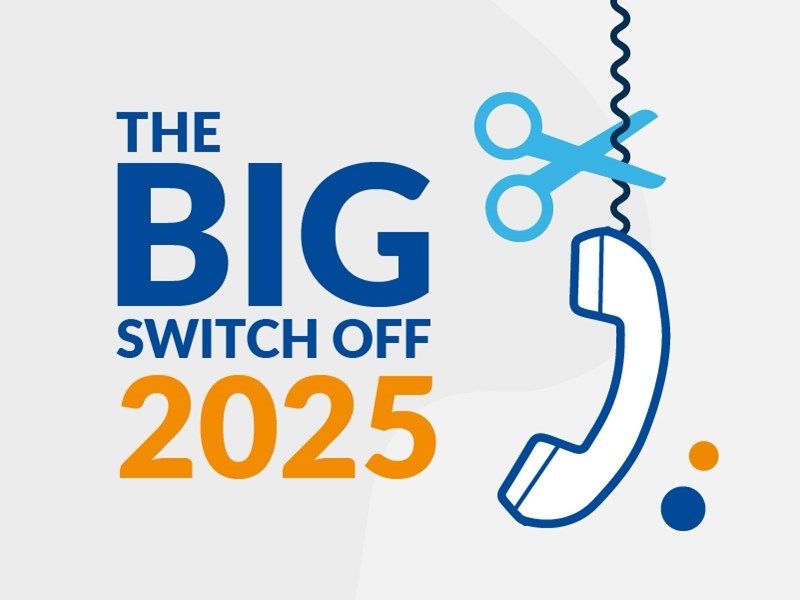The Impending PSTN Switch Off: Navigating the Future of Telecommunications

The PSTN Switch Off: Where Do We Go From There?

If you scroll a lot on LinkedIn, I’m pretty sure that you crossed paths with this phrase more than once: “PSTN switch off.” And you’ve probably asked yourself, What the hell does that mean? But you weren’t interested enough, brushed it off and didn’t research further. I’m here to tell you that you should pay attention to this, whether you are a business owner, a manager in a company or an entry-level employee. This, in fact, might affect your job or your business.
What does PSTN stand for?
PSTN stands for Public Switched Telephone Network. It basically that enstilled photo in your mind that includes a switch board and operators diverting and connecting calls that you’ve seen in old movies. And here’s one for the chuckles: PSTN is also known as POTS. Which stands, I kid you not, for Plain Old Telephone Service.
Very good. Now that you know what PSTN stands for, let’s combine the two phrases together. PSTN switch off. So the public switched telephone network is switching off, so what? How will that affect me? You might be asking. Well, that means that the backbone of communications that held together all lines across the world is finally coming to an end. All the copper wires and the cables that connected you with your friends back in the day, when you used to extend the chord just a bit more so you could reach the fridge while talking on the phone, are going to become obsolete.
When is the PSTN switch off?
In 2025. Once this happens, the traditional phone lines cannot be used anymore, and they will be replaced by internet-enabled networks.
But Why?
We have relied massively for the last century on this system to keep us all connected. However, with the vigorous technological advancements that we’re witnessing in the 21st century. Change is inevitable. The emergence of the internet has managed to take over a lot of what we were used to. It is slowly becoming the cornerstone of everything that we operate on today.
Here are a few reasons why this change was bound to happen sooner or later:
1.) Digital Transformation

This is the main drive behind the PSTN switch off. Emerging technologies like Voice over Internet Protocol (VoIP) and mobile networks are currently dominating the communications field and for good reason. They are more reliable, cost-effective, and easily accessed and maintained. Not to mention the myriad of new features they allow. VoIP now allows you to do a conference call with more than one participant. It allows you to install an IVR at the beginning of the call, which is the automated voice that says press 1 for sales and 2 for customer service, which annoys us all. Also, it allows the feature of call forwarding, where you can forward a call to another number. You can also leave a voice message if the person you’re calling does not pick up. And these are just a few examples of the upgrades businesses and individuals are getting from this switch.
2.) Maintenance Challenges
Most of us have been through the case of changing a “chord” because it is just worn out. Imagine millions of very large cables that connect the whole world. The sheer amount of work needed to keep these up and make them functional around the clock alone gives me a slight headache. Now, keep in mind that these cables are sometimes undersea or in remote places. That makes maintaining and servicing them much harder. The PSTN switch off serves as a strategic move to allocate all this manpower and budget to something that is easier to handle and maintain, another resource that is more advanced and is a lot more hassle-free than cables and chords in the ground and undersea.
3.) Global Standardization
Countries around the world need a unified method of communication that aligns with the developments of the world. The PSTN simply cannot keep up with the technological advancements that we’re currently witnessing. That’s why the PSTN switch off makes sense.
So What Is the Impact of the PSTN Swtich Off on Businesses and Individuals?
Obviously, the shift is huge. And it could pose some challenges to adapting to the new changes.
Of course, everybody is familiar with mobile networks and how to make calls from their cell phone. But people are not very accustomed to VoIP. The term might seem a bit technical but it’s very simple. VoIP stands for Voice over Internet Protocol and it’s simply the breakdown and transfer of packets of voice through the Internet to be complied on the other end and clearly heard by the other party. So while your voice was transmitted through chords via the PSTN, it's now transmitted through the Internet via VoIP. So what are the implications of the PSTN switch off and how ill it affect businesses and individuals?
1.) Cost Savings

First and foremost, savings. And with that word alone, people are already half-convinced. Yes, VoIP and other digital alternatives are much more cost-effective than traditional land lines. The reasons for that are that the Internet itself is readily available to almost everyone around the world at low prices and because of the high maintenance costs associated with the land lines that we previously spoke about. For that reason, the PSTN switch off makes more sense for businesses and individuals. You get a higher-quality service for less than what you pay. What’s not to like?
2.) Enhanced Features

At first glance, you might not think there are a whole lot of features to a phone, right? I mean, if I say hello and the other party hears it on the other side, what more do I need? Well, you might be wrong. VoIP allows for a lot of features that could enhance your business operations and improve your customer service and sales performances. Take video calling for example. That is one innovative feature that takes communication to the next level. The ability to see the other person that you’re talking to while you’re talking to them was a huge step forward when it was first possible.
Another feature that we briefly mentioned is conference calling. Now you are able to have large virtual meetings with multiple people at the same time. The ability to group your employees into separate departments and have the automated attendant direct calls to the right department. One other underrated feature is call queuing. Back in the day, if you called someone and they were on the phone, you got a busy tone. But now you can have the feature of call queuing and allow the person to wait in the queue until you’re done with the call. These are just a few examples of what VoIP could offer you, and there are a lot more features to be discovered.
3.) Challenges for Legacy Systems
Businesses and individuals relying on PSTN for their phones may encounter some challenges with the switch. That’s why correct planning and knowing exactly what you need go a long way. So what exactly do you need to do?
So What’s Next?
To be able to navigate the PSTN switch off smoothly, consider the following points:
1.) Evaluate Your Current System
You need to understand how many users you currently have. How much do you use the phone on a monthly basis? Would you like to switch to a digital dialer or keep using the physical phones? If you choose the physical phones, how many should you get? Do you want to buy them or lease them? These are some questions that you should be asking yourself to ensure an easy transition. You can always reach out to us for guidance, and we’ll be more than glad to help you.
2.) Invest in Modern Solutions

There are a lot of VoIP providers out there. You need to know what features your business needs and what your budget is, and ask yourself five important questions so that you can pick the right vendor and be able to do the transition seamlessly.
3.) Educate your Employees and Stakeholders
Change is met with resistance. That is the way of the world. That’s why you need to make sure that you explain to your stakeholders why you need to make that change. And more importantly, you need to educate your employees on how to use the new system. At Tonet, we not only provide you with the service of VoIP, but we also train your employees on how to use the system to make sure the learning curve takes a lot less time than it normally should.
In Summary
The PSTN switch off is around the corner, and for good reasons. The whole world is moving in the direction of digital transformation and communications is no exception. With a more cost-effective, feature-rich alternative, internet-enabled will be taking place. Be sure to evaluate your current system if you’re still using land lines and plan your switch to ensure a smooth transition and avoid any business interruptions.

Comments ()